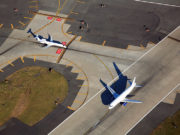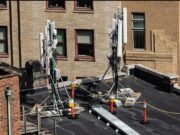
A move by the U.S. Federal Communications Commission (FCC) to allow 5G telecommunications systems to use the 3.7-3.98 GHz frequency spectrum presents a “major risk … of harmful interference” with radar altimeters on civil aircraft, according to new research by RTCA.1
The organization, a public-private partnership that advises the U.S. Federal Aviation Administration (FAA) and works to develop consensus on aviation modernization issues, said in a report issued early in October that if 5G telecommunications systems are permitted to use that frequency band, “the risk is widespread and has the potential for broad impacts to aviation operations in the United States, including the possibility of catastrophic failures leading to multiple fatalities, in the absence of appropriate mitigations.”
The FCC’s plan calls for the spectrum to be made available for “flexible use,” including 5G, through an auction to new licensees that is set to begin in December.
RTCA noted in its report that during the rulemaking process, the aviation industry had commented that allowing 5G networks on the frequency band might introduce harmful interference with radar altimeters, which operate worldwide on the 4.2-4.4 GHz aeronautical band.
Radar altimeters, which are used on thousands of civil aircraft around the world, are the only sensors in these aircraft that directly measure the height of the aircraft above terrain and other obstacles. They provide critical information to a number of aircraft systems, including terrain awareness and warning systems (TAWS), traffic-alert and collision avoidance systems (TCAS), wind shear detection systems, flight control systems and autoland systems. In addition, the measurements obtained by radar altimeters are used by electronic centralized aircraft monitoring (ECAM) systems and engine-indicating and crew alerting systems (EICAS), among others.
“Failures of these sensors,” RTCA said, “can therefore lead to incidents with catastrophic results,” including accidents resulting in multiple fatalities.
The RTCA report noted that the aviation industry told the FCC earlier this year that additional study is needed to evaluate the effects on radar altimeters of radio frequency interference from 5G networks operating within the aeronautical GHz band. An RTCA special committee established in April conducted one study aimed at determining the likely extent of interference and the associated risks.
Radar altimeters work by transmitting radio frequency energy from an aircraft to the ground and then receiving some of that energy back through reflection off the ground or an obstacle; the time it takes for the energy to make that round trip enables calculation of the aircraft’s height above the ground or the obstacle.
The radiated power level is about 1 watt, “and thus highly sensitive receivers are required for radar altimeters to function properly,” the report said. “As such, radar altimeters are highly susceptible to [radio frequency] interference entering the receiver, which can negatively impact their performance.”
Although radar altimeters operate within the aeronautical band, they may be susceptible to interference either within that band or within nearby frequency bands, the report said, adding that the reallocation of the frequency band would result in problems involving not only intentional emissions from 5G transmissions but also “spurious emissions from such systems within the protected 4.2-4.4 GHz radar altimeter band.”
The report noted that radar altimeters have been installed in civil aircraft since the 1970s, with no substantial issues of harmful radio frequency interference, largely because the 4.2-4.4 GHz aeronautical band has been protected and interference from adjacent bands has been “generally benign and compatible with radar altimeter operations.”
The introduction of mobile telecommunications networks in the 1990s and their expansion during the next two decades also presented no serious risks, the report said.
More recently, however, regulators in the United States and many other countries have made additional parts of the frequency spectrum available for telecommunications to support 5G networks. In March, the FCC ordered the reallocation of 3.7 to 3.98 GHz for new flexible use, including 5G networks. As a result, plans call for those frequencies to be auctioned beginning in December.
RTCA said its members were prepared to work with regulatory authorities and industry representatives on additional analysis of the risks and development of methods of risk mitigation.
“Given the extent to which the safe interference limits are exceeded and the breadth of the impacts to aviation safety, the risk of harmful interference to radar altimeters cannot be adequately mitigated by the aviation industry acting alone,” the report said, adding that the participation of the mobile wireless industry also will be needed.
Note
- RTCA. RTCA Paper No. 274-20/PMC-2073, “Assessment of C-Band Mobile Telecommunications Interference Impact on Low Range Radar Altimeter Operations.” Oct. 7, 2020.



